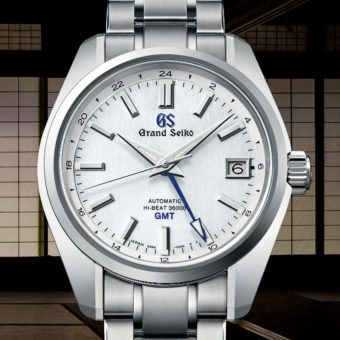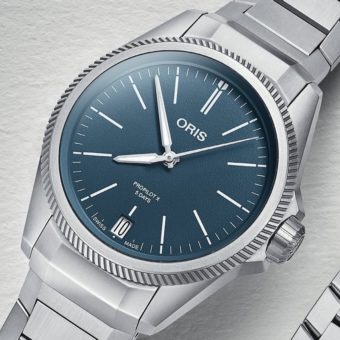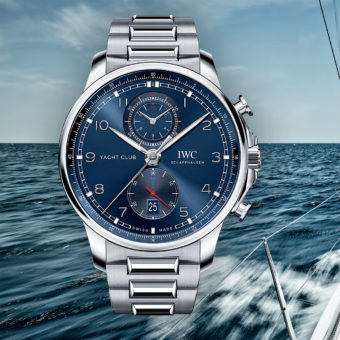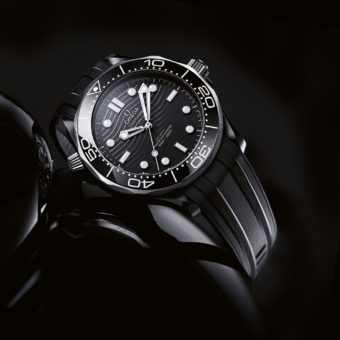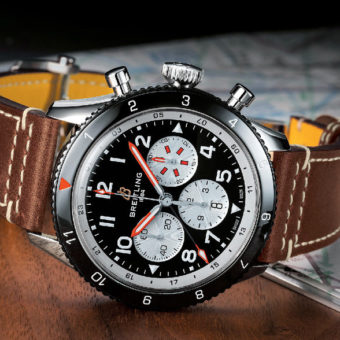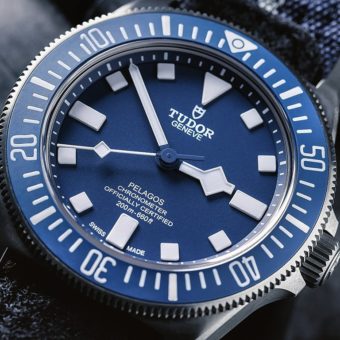
Similar in styling, both German made. Which of these two measuring-instrument-inspired watches fared better in our test, Meistersinger or Mühle? Julia Knaut tackled the issue in this test. With images by OK-Photography.
The Meistersinger brand, based in Münster, Germany, specializes in watches that draw their inspiration from measuring instruments: speedometers, altimeters, manometers and the like. Mühle-Glashütte, in the German watchmaking town of Glashütte, makes watches in a similar vein. The company has a 140-plus-year history of making nautical measuring devices (barometers, hygrometers, chronometers, etc.) and evokes that heritage in the watches it makes today. We pitted the two brands against each other, choosing Mühle’s M 29 Classic to go head to head with Meistersinger’s Pangaea. Both have Sellita movements: the SW 200 and SW 220, respectively.

Mühle’s three-handed M 29 is patterned after one of the company’s historical measuring instruments, Model 29, which was used to manually calculate drilling depths. The watch’s easy-to-read, cream-colored dial, which has a darker center, is enlivened by black and red markings like those on the original instrument. The watch’s technical-looking styling is enhanced by numerals for the minutes printed along the beveled flange and by precise subdivisions along the seconds scale, which has three short strokes between each pair of longer full-second marks. There is a small date window at 3 o’clock.
The dial of the Meistersinger is similar in color to the Mühle dial but is more complex, composed of multiple layers and equipped with a day display as well as a date. A lone hand indicates both the hours and the minutes. Hours are marked in the conventional manner, with numerals 1 through 12 (paired with bold line markers); half hours are shown by somewhat shorter, lighter line markers; and quarter hours and five-minute intervals by still shorter markers. The single-digit hour numerals are each preceded by a “0” in the manner of many measuring instruments. Two lower-lying disks rotate beneath the dial’s elevated center to show the day and date, both of which are indicated by a stationary red arrow at the 12 o’clock position.
The Pangaea’s minutes and date displays aren’t as precise as those on Mühle’s watch, and hence gainsay the measuring-instrument styling somewhat. The minutes scale is accurate only to the nearest five minutes and the date disk reduces each even-numbered date to a simple dark stroke. Although the dial is more elaborate than that of the M 29, it could have been more painstakingly engineered and assembled. Meistersinger buys the disks for the Sellita SW 220’s day and date indicator from a third party. An unattractive crevice separates the two disks, and on our tested watch, the crevice’s size was not uniform around the circumference of the inner, day disk.

The case of the M 29 is quite hefty and angular, and is somewhat at odds with the warm-colored dial and its rather refined numerals and markers. Numerous matte surfaces, straight lugs pointing diagonally downward and a large crown protector contribute to the case’s brawny, technical appearance. Despite the mild dissonance between case and dial, the case is well crafted, although the crown on the watch we tested wiggled slightly when we pulled it out.
The Pangaea’s case is more elegant and genteel. Its rounded, polished sides harmonize with its slim, arcing lugs. The bezel is narrow, leaving ample room for the dial’s finely detailed indicators. These match the case better than their counterparts on Mühle’s watch, although they somewhat compromise the watch’s “technical” look. The Pangaea’s case is more simply constructed than Mühle’s case: its contours are less complex and its crown is not screwed. The window on the back is made of mineral glass rather than sapphire, and the bezel is merely pressed on. The crown nonetheless fits very firmly in the case even after it has been pulled out.
The first requirement of a watch with a measuring-instrument theme is that it be easy to read. Mühle meets this demand with a high-contrast dial, elongated and sharply pointed hands, and richly detailed scales. The numerals, however, could be bolder. The Pangaea has the same high contrast as the M 29, but the days are printed in small type and it’s hard to read them quickly. And, as we’ve pointed out, the minutes cannot be read precisely. Mühle’s watch is generally more legible thanks to its tidier dial. It’s also easier to use. The crown is large and deeply knurled for a non-slip grip, although unscrewing the crown is made somewhat harder by the crown protector. The detailed displays make it simple to adjust the hands, and setting the date is also easy. With the Meistersinger, though, you have to cope with a flat crown that’s positioned very close to the case and can only be pulled out with the help of a fingernail. But after it’s out, the displays are as easy to set as those on the Mühle watch.
The wide, thick calfskin strap of the M 29 is designed for brawny wrists. It is a good match for the very robust case, but the insubstantial buckle, which has a curved prong, is merely stamped from sheet metal. Despite the heft of the case and strap, the watch fits comfortably around the wrist. The Meistersinger’s neatly crafted cut-calfskin strap is embossed with a crocodile pattern and culminates in a high-quality milled buckle equipped with a milled prong. Thanks to its rounded case and padded strap, the Pangaea is even more comfortable on the wrist than its competitor.

But Mühle knocks its opponent out in the technical arena. It makes several modifications to its SW 200 base movement. Mühle enhances the movement in accord with the traditional rules of watchmaking in Glashütte. These specify that if a watch is to earn the right to bear the label “Glashütte” on its dial, at least 50 percent of the value of the movement must result from work performed in that town. Mühle therefore equips its Sellita base with its own woodpecker’s neck fine adjustment mechanism, as well as a new balance cock and Mühle’s own rotor. The caliber is further embellished with blued screws and the brand’s tasteful polished patterns. Mühle makes the regulating organs and the rotor on its own premises. The cocks and screws are purchased from suppliers in Glashütte.
Meistersinger, on the other hand, does not make any technical alterations to its SW 220 other than removing the seconds hand. But the movement does have more decoration than Mühle’s does. The movement is finely adjusted via a regulator and eccentric screw. With Mühle’s woodpecker’s neck adjustment mechanism, the balance spring’s active length can be finely altered by turning a screw that presses against the regulator arm, which is held in place by a counteracting spring. Both systems are stable but Mühle’s provides a finer adjustable range.
This has obviously paid off, at least in the model we tested, because the M 29 was more accurately adjusted than its opponent. The greatest daily deviation among the various positions was five seconds and the average daily deviation was +3.8 seconds. Meistersinger’s watch gained only 1.5 seconds per day, but the largest deviation among the positions was a much less satisfactory 12 seconds. Both watches had laudably stable balance amplitudes. As for value, the Mühle’s price, $1,899, is reasonable considering the attractive styling, the modifications performed on the movement, and the craftsmanship of the case. By comparison, the Meistersinger’s price, $2,825, seems too high, although its watch does have a day display while the Mühle doesn’t. All in all, the Mühle outdoes the Meistersinger, especially when the movements and the dials’ legibility are compared. Mühle’s lower price also proves that a buyer need not always pay more for a movement that the brand has modified itself.
SPECS/MUHLE:
Manufacturer: Mühle-Glashütte GmbH, Altenberger Strasse 35, D-01768 Glashütte, Germany
Reference number: M1-25.57-LB
Functions: Hours, minutes, seconds, date, stop-seconds function
Movement: Sellita SW 200 “Special” quality grade, automatic 28,800 vph, 26 jewels, Incabloc shock absorption, Mühle’s own rotor, woodpecker’s neck fine adjustment mechanism and balance cock, 38-hour power reserve, diameter = 26 mm, height = 4.6 mm
Case: Stainless-steel case, flat sapphire crystal with nonreflective coating inside, six screws hold back in place, back with sapphire window, water resistant to 100 m
Strap and clasp: Cut-calfskin strap with stainless-steel pronged buckle
Rate results (Deviations in seconds per 24 hours):
Dial up +6
Dial down +5
Crown up +2
Crown down +5
Crown left +1
Crown right +4
Greatest deviation of rate 5
Average deviation +3.8
Average amplitude:
Flat positions 290°
Hanging positions 281°
Dimensions: Diameter = 42 mm, height = 11.3 mm, weight = 101 g
Variations: Black dial; stainless-steel bracelet ($1,999)
Price: $1,899
SPECS/MEISTERSINGER:
Manufacturer: Meistersinger GmbH & Co. KG, Hafenweg 46, D-48155 Münster, Germany
Reference number: PDD903
Functions: Hours, minutes, date, day, stop-seconds function
Movement: Sellita SW 220 “Special” quality grade, automatic, 28,800 vph, 26 jewels, Incabloc shock absorption, fine adjustment via regulator and eccentric screw, 38-hour power reserve, diameter = 26 mm, height = 5.1 mm
Case: Stainless-steel case, domed sapphire crystal with nonreflective coating inside, six screws hold back in place, mineral crystal caseback, water resistant to 50 m
Strap and clasp: Calfskin strap with crocodile embossing and stainless-steel pronged buckle
Rate results (Deviations in seconds per 24 hours):
Dial up +2
Dial down +1
Crown up -4
Crown down +8
Crown left -2
Crown right +4
Greatest deviation of rate 12
Average deviation +1.5
Average amplitude:
Flat positions 276°
Hanging positions 256°
Dimensions: Diameter = 40 mm, height = 10.5 mm, weight = 69 g
Variations: Black-and-white dial; straps in various colors
Price: $2,825
SCORES/MUHLE:
Strap and clasp (max. 10 points): The thick calfskin strap is neatly crafted, with the sole exception of the less than ideal pronged buckle. 7
Operation (5): The crown’s protector interferes somewhat with the task of unscrewing the crown. But the knurling on the crown makes it easy to operate all of the watch’s functions. 4
Case (10): The heavy case boasts high-quality craftsmanship and is quite solid. 8
Design (15): Handsome styling patterned after historical measuring instruments, but the angular and thick case looks a bit too bulky. 13
Legibility (5): The dial’s high contrast is somewhat less effective than it could be because the hands are a little too thin. 4
Wearing comfort (10): Despite its heavy weight, this watch is very comfortable on the wrist, thanks to its broad strap. 9
Movement (20): Mühle adds its own components to modify a standard Sellita movement. Except for the blued screws, the embellishments are quite unobtrusive. 12
Rate results (10): The greatest deviation among the several positions was slightly more than five seconds per day and the average daily deviation was +3.8 seconds. 8
Overall value (15): For a relatively low price, this watch offers an interesting movement and high-quality craftsmanship. 14
TOTAL: 79 POINTS
SCORES/MEISTERSINGER:
Strap and clasp (max. 10 points): The embossed calfskin strap is neatly crafted. The clasp and the prong are milled from solid blocks of metal. 8
Operation (5): The flat crown can only be pulled out if you use your fingernail, but non-slip knurling makes adjusting the displays easy. 4
Case (10): The case, which seems somewhat dainty, is simply constructed, having a mineral glass window in the back and a pressed-on bezel, but the crown fits very firmly in the case. 7
Design (15): The crowded dial and elegant case detract from the measuring-instrument styling. 12
Legibility (5): Despite the high-contrast dial, the numerous elements on the dial and the small day display interfere with legibility. 3
Wearing comfort (10): This watch fits perfectly on the wrist thanks to a padded strap and a lightweight case with a rounded back 10
Movement (20): The Sellita movement (with displays for the date and the day) is used without any technical alterations, but does have various decorative embellishments. 11
Rate results (10): The movement gained an average of only 1.5 seconds per day, but the greatest deviation among the various positions was an excessive 12 seconds. 7
Overall value (15): Considering the unaltered movement and the simple case, the price is high. 11
TOTAL: 73 POINTS
This article appeared in the April 2014 edition of WatchTime Magazine.

